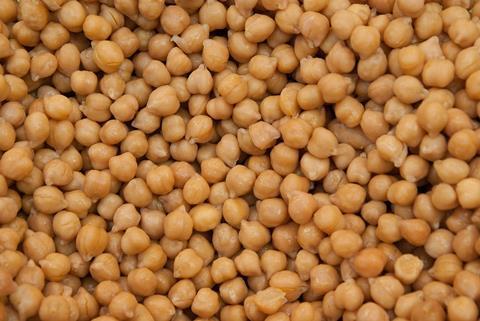University of Massachusetts Amherst food scientist Hang Xiao is tackling a new challenge in his ongoing aim to develop tasty, nutritious and sustainable plant-based alternatives to animal meat.

His new research, funded with a four-year, $387,000 grant from the USDA’s Pulse Crop Health Initiative, focuses on fermenting dry chickpeas and dry peas to create a new type of tempeh, traditionally made with soybeans. Preliminary research suggests that chickpea and pea tempeh may help offset the health risks of the Western diet, such as obesity, fatty liver, hyperlipidemia and diabetes.
The challenge Xiao faces is uncovering the science involved in a process that’s been practiced for hundreds of years. He will use the expertise of two UMass Amherst co-investigators to carry out the research – sensory scientist Alissa Nolden, assistant professor of food science, and John Gibbons, associate professor of food science, who uses genomic approaches to study fungi in fermented foods.
Fermented fungal food
“Tempeh is a fermented, fungal food that originated from Indonesia but is now gaining popularity all around the world because it’s a good approach to producing plant-based protein food,” says Xiao, year in and year out one of the world’s most highly cited researchers, according to data analytics company Clarivate. “Tempeh fermentation is mainly done empirically without a scientific understanding of the molecular basis by which fungal fermentation impacts product functionality, such as nutritional and sensory properties and health impact. This limits our ability to develop tempeh-based meat alternatives with optimal functionalities.”
READ MORE: Researchers deploy fungus to extract useful proteins from beer-brewing leftovers
READ MORE: Research reveals probiotic potential of Nigerian fermented foods
Functionality includes both taste and nutrition. For the chickpea and pea tempeh to function practically as a plant-based meat option, it needs to be tasty.
“If it’s not tasteful, people won’t like it, and they won’t consume it frequently enough to offer health benefits,” Xiao says. “That’s one of the major challenges of plant-based protein.”
Smart fermentation
Xiao is also using “smart fermentation” in another project to develop a high-quality, plant-based protein from soybean meal, the byproduct of soybean oil extraction.
In the new project, Xiao and team will develop the tempeh products from chickpeas and peas and then “study the dynamic changes – because the fungi will be utilizing the nutrients in the peas and then transform them into different compounds. And this will have an impact on the nutritional value and the sensory properties of the final products,” he says.
The food scientists will conduct a chemical analysis to determine which compounds, including amino acids and flavonoids, are produced during fermentation. Preliminary data suggests a nutritious high-fiber, low-fat tempeh will result.
Sensory profile
The team will also gather a panel of consumers to rate the sensory profile of the tempeh products – their taste, smell and texture. Finally, the researchers will determine the health impact of tempeh in an obese rodent model induced by the Western diet high in animal fat and sugar, a scenario designed to mimic the way many people typically eat.
“People consume everything mingled together,” Xiao says. “This dietary intervention is a preventive measure. We want to see if the tempeh products counteract the bad influence of the high-fat, high-sugar diet.”
Preliminary research showed promising results – that feeding obese mice chickpea tempeh did inhibit high-fat diet-induced body weight gain, fatty liver formation and negative changes in the gut microbiome, among other impacts. “These findings are important because they suggested that tempeh fermentation enhanced health benefits of chickpeas and provided a strong rationale to develop pulse-based tempeh with desirable health functions,” the grant summary concludes.







No comments yet